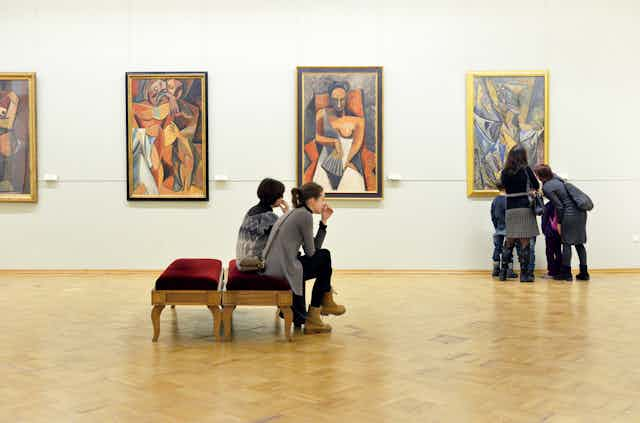Posh, soft, elite, decorative on the one hand, unreadably intellectual, dry and obscure on the other. Either too soft or too tough. So let’s cheer as the last chance for it to be studied at A-level gets binned.
That’s art history for you, according to the Guardian’s Jonathan Jones, venting his class spleen against the subject by effectively calling it girly, even a bit queer – his sideswipe against art history students he met at Cambridge all “kitted out like Sebastien Flyte” of Brideshead Revisited. It’s the “posh white girls” (and, for Jones, it seems, the fay young men) who are unjustifiably taking the brunt of the reports on exam board AQA’s axing of the one proposed A-level in art history.
Internationally considered a serious scholarly field, the subject in question, art history, is dedicated to both historical research and the critical conservation and analysis of cultural heritage in its material forms and its immaterial, imaginative and political effects.
So let us start with that loaded word: posh. If we analyse the figures for students doing any A-levels and turning up in Russell Group universities in all subjects, we find a high percentage are still from private schools. This is not something unique to art history students.
So you cannot use the figures currently being bandied about in the press about art history being taught more in private schools to “stain” art history any more than other arts subjects. For all our struggle to democratise access, education in the UK is still a strongly white middle-class aspiration supported by that class’s financial resources. And this situation is only worsening since the abolition of the 20th century experiment in free higher education as a method of increasing social mobility. Class is a fact of British society. We should not be making it worse.
A different perspective
That’s my point. The killing off of art history at A-level is a blow against democratisation. A lack of art history will deprive all young people of opportunities for new kinds of knowledge of the world they live in. It will close down the chance to acquire an understanding of the past and of the present through image and object, place and building, powerful patrons and craftspeople and makers.
Far from dismissing this subject because at present it is more often taught in independent schools, we need to be insisting on the value of this way of learning about the world through its cultures, its monuments, its legends, its visual story-telling, its creative imaginations — for all young people in all schools.
We need to insist that the way art history is conceived and taught now expands horizons and is not just the old story of European white men. We should be trying harder to give more opportunities to young people in state education to have access to art and culture as the means of learning about themselves, their histories and their worlds through its study.
Prior to the decision to axe the subject, AQA had been developing a new A-level that received widespread approval. It was specifically designed to speak to a socially diverse and multicultural society, to make visible issues of class, race, gender and sexualities, to address the question of global citizenship through encounter with varied visual and material cultures. The proposed A-level was aimed specifically to teach critical skills in visual analysis in the face of mass information and the spectacle and lure of media image culture. Such skills are urgently needed by young people because of the visual cultures of the social media they inhabit.
For many children in state schools, who may not have the advantages of frequent travel or other occasions to encounter not just art but material culture, this may have been their only opportunity to have these doors opened.
And other doors – because art history is a portal to a range of work fields, from high-level art marketing to curation and conservation and, of course, museum and gallery education that is aimed a future generations. And let us also remember that the A-level is also a doorway to architecture and design.
Hardly soft
Art history is neither soft nor decorative – nor am I, as a middle class white woman and professor. It is a way to see what people thought, felt, believed, did, and imagined, by looking at the material things – buildings, paintings, gardens, sculptures, images, cities, objects – and the worlds that they made. It encompasses theology as much as pigment, philosophy as much as building techniques, languages as much as global histories of trade or the violence of enslavement. One has to grasp the systems of thought, political and economic processes as much as the image worlds and visual cultures of the many civilisations and cultures on the globe.
It is intellectually challenging, historically sensitive, and, above all, it trained me to look analytically and think historically.
That is why some of the great minds of the past and present turn to it, including white and black, straight and queer, and from every corner of the globe. Jones only seems to have heard of Clark and Gombrich – distinguished art historians but of an earlier era. The growth of the subject in British schools and universities since the 1960s is testament to this interest.
I cannot protest loudly enough at the ignorant, prejudiced and gender and class stereotyped caricature of art history as not a “proper” discipline or a substantial subject and the hostility to art and thinking critically about it that underlies it.
Rather than attack the subject, give all the kids a chance to study it.

